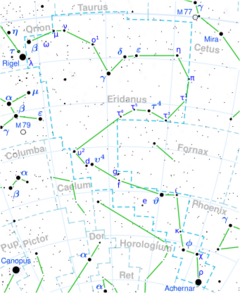Astronomy:Tau5 Eridani
| Observation data Epoch J2000.0 Equinox (celestial coordinates) | |
|---|---|
| Constellation | Eridanus |
| Right ascension | 03h 33m 47.27613s[1] |
| Declination | −21° 37′ 58.3830″[1] |
| Apparent magnitude (V) | 4.26[2] |
| Characteristics | |
| Spectral type | B0 V + B9 V[3] |
| U−B color index | 0.35[2] |
| B−V color index | −0.09[2] |
| Astrometry | |
| Proper motion (μ) | RA: +44.94[1] mas/yr Dec.: −28.16[1] mas/yr |
| Parallax (π) | 11.12 ± 0.21[1] mas |
| Distance | 293 ± 6 ly (90 ± 2 pc) |
| Absolute magnitude (MV) | −0.51[4] |
| Orbit[5] | |
| Period (P) | 6.2236 d |
| Eccentricity (e) | 0.2 |
| Periastron epoch (T) | 2424446.548 JD |
| Argument of periastron (ω) (secondary) | 313° |
| Semi-amplitude (K1) (primary) | 107 km/s |
| Semi-amplitude (K2) (secondary) | 103 km/s |
| Details | |
| τ5 Eri A | |
| Mass | 3.30+0.24 −0.20[6] M☉ |
| Radius | 3.2[3] R☉ |
| Luminosity | 188[7] L☉ |
| Surface gravity (log g) | 4.00±0.15[6] cgs |
| Temperature | 12,514±425[8] K |
| Rotational velocity (v sin i) | 55±8[3] km/s |
| Age | 157+23 −45[6] Myr |
| τ5 Eri B | |
| Radius | 2.6[3] R☉ |
| Rotational velocity (v sin i) | 50±8[3] km/s |
| Other designations | |
| Database references | |
| SIMBAD | data |
Tau5 Eridani, Latinized from τ5 Eridani, is a binary star system in the constellation Eridanus. It is visible to the naked eye with a combined apparent visual magnitude of 4.26.[2] The distance to this system, as estimated using the parallax technique, is around 293 light years.[1]
Tau5 Eridani is a double-lined spectroscopic binary system.[10] The two stars orbit each other closely with a period of 6.2 days and an eccentricity of 0.2.[5] On average, the two stars are separated by around 0.183 AU.[3]
The primary component is a B-type main sequence star with a stellar classification of B0 V.[3] It is around 157 million years old and is spinning with a projected rotational velocity of 55 km/s.[3] The star has around 3.3[6] times the mass of the Sun and 3.2[3] times the Sun's radius. It radiates 188[7] times the solar luminosity from an outer atmosphere at an effective temperature of 12,514 K.[8]
The secondary component has a stellar classification of B9 V.[3] It is slightly smaller, with an estimated size equal to 2.6 times the radius of the Sun.[3]
Although τ5 Eridani has no bright visual companion stars, the galaxy IC 1953 is less than 10' away. It is one of the brighter members of a loose group of galaxies called the Eridanus Group scattered around the components of τ Eridani.
References
- ↑ 1.0 1.1 1.2 1.3 1.4 1.5 van Leeuwen, F. (2007), "Validation of the new Hipparcos reduction", Astronomy and Astrophysics 474 (2): 653–664, doi:10.1051/0004-6361:20078357, Bibcode: 2007A&A...474..653V.
- ↑ 2.0 2.1 2.2 2.3 Mermilliod, J.-C. (1986), "Compilation of Eggen's UBV data, transformed to UBV (unpublished)", Catalogue of Eggen's UBV Data (SIMBAD), Bibcode: 1986EgUBV........0M.
- ↑ 3.00 3.01 3.02 3.03 3.04 3.05 3.06 3.07 3.08 3.09 3.10 Howe, K. S.; Clarke, C. J. (January 2009), "An analysis of v sin (i) correlations in early-type binaries", Monthly Notices of the Royal Astronomical Society 392 (1): 448–454, doi:10.1111/j.1365-2966.2008.14073.x, Bibcode: 2009MNRAS.392..448H.
- ↑ Anderson, E.; Francis, Ch. (2012), "XHIP: An extended hipparcos compilation", Astronomy Letters 38 (5): 331, doi:10.1134/S1063773712050015, Bibcode: 2012AstL...38..331A.
- ↑ 5.0 5.1 Pourbaix, D. et al. (2004), "SB9: The ninth catalogue of spectroscopic binary orbits", Astronomy and Astrophysics 424 (2): 727–732, doi:10.1051/0004-6361:20041213, Bibcode: 2004A&A...424..727P.
- ↑ 6.0 6.1 6.2 6.3 Gullikson, Kevin et al. (August 2016), "The Close Companion Mass-ratio Distribution of Intermediate-mass Stars", The Astronomical Journal 152 (2): 13, doi:10.3847/0004-6256/152/2/40, 40, Bibcode: 2016AJ....152...40G.
- ↑ 7.0 7.1 McDonald, I. et al. (2012), "Fundamental Parameters and Infrared Excesses of Hipparcos Stars", Monthly Notices of the Royal Astronomical Society 427 (1): 343–57, doi:10.1111/j.1365-2966.2012.21873.x, Bibcode: 2012MNRAS.427..343M.
- ↑ 8.0 8.1 David, Trevor J.; Hillenbrand, Lynne A. (2015), "The Ages of Early-Type Stars: Strömgren Photometric Methods Calibrated, Validated, Tested, and Applied to Hosts and Prospective Hosts of Directly Imaged Exoplanets", The Astrophysical Journal 804 (2): 146, doi:10.1088/0004-637X/804/2/146, Bibcode: 2015ApJ...804..146D.
- ↑ "tau05 Eri". SIMBAD. Centre de données astronomiques de Strasbourg. http://simbad.u-strasbg.fr/simbad/sim-basic?Ident=tau05+Eri.
- ↑ van Rensbergen, W. et al. (February 2006), "Evolution of interacting binaries with a B type primary at birth", Astronomy and Astrophysics 446 (3): 1071–1079, doi:10.1051/0004-6361:20053543, Bibcode: 2006A&A...446.1071V.
 |


